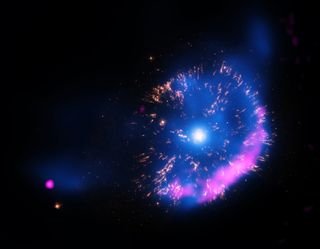Century-Old 'Mini-Supernova' Captured in Gorgeous NASA Photo

A stunning new photo shows the expanding celestial fireworks created by a stellar explosion that first lit up Earth's skies more than a century ago.
The image, taken by NASA's Chandra X-ray Observatory, depicts GK Persei, a sort of mini-supernova that first appeared in the night sky in 1901. Scientists aimed Chandra at GK Persei in February 2000 and then again in November 2013, measuring the brightness and temperature of the expanding debris both times.
Chandra's data have revealed something surprising: The gas in GK Persei — which lies 1,500 light-years from Earth, in the direction of the constellation Perseus — hardly cooled at all during the 13-year span, researchers said. [See a time-lapse video of the GK Persei explosion]
A hundred thousand years ago, GK Persei was a typical sunlike star on death row. It ran out of hydrogen fuel and shed its outer layers, transforming into a superdense stellar corpse called a white dwarf.
But GK Persei's story was far from over. The white dwarf pulled hydrogen gas from the outer layers of an orbiting companion star, accumulating enough material to spur nuclear-fusion reactions. This eventually led to a huge explosion. The white dwarf's outer layers were blown off, in an event known as a "classical nova."
Such events can be thought of miniature versions of supernova explosions, which involve the death and complete destruction of stars much more massive than the sun, researchers said.
The light from GK Persei's explosion first arrived at Earth in 1901 — 1,500 years after the star went boom. For a brief time, GK Persei was the brightest object in the night sky. It has faded over the decades, but the object can't escape the peering eyes of Chandra and other powerful telescopes.
Get the Space.com Newsletter
Breaking space news, the latest updates on rocket launches, skywatching events and more!
The new photo shows Chandra data in blue, optical data from the Hubble Space Telescope in yellow and radio data from the Very Large Array (VLA) in pink. Chandra's X-ray observations reveal hot gas; Hubble's show clumps that were ejected in the explosion, and the VLA data reveal emission from electrons, NASA officials said.
Chandra's observations show that GK Persei's debris expanded outward at about 700,000 mph (1.1 million km/h) between 2000 and 2013, moving about 90 billion miles (145 billion kilometers) during that time, researchers said.
The data also reveal that the temperature of gas in the nova remnant remained more or less constant from 2000 to 2013, a finding that was unexpected.
"As the shock wave expanded and heated an increasing amount of matter, the temperature behind the wave of energy should have decreased," NASA officials wrote in a statement.
"The observed fading and constant temperature suggests that the wave of energy has swept up a negligible amount of gas in the environment around the star over the past 13 years," they added. "This suggests that the wave must currently be expanding into a region of much lower density than before, giving clues to the stellar neighborhood in which GK Persei resides."
The results were published in the March 10 issue of the Astrophysical Journal.
Follow Shannon Hall on Twitter @ShannonWHall. Follow us @Spacedotcom, Facebook and Google+. Original article on Space.com.
Join our Space Forums to keep talking space on the latest missions, night sky and more! And if you have a news tip, correction or comment, let us know at: community@space.com.

Shannon Hall is an award-winning freelance science journalist, who specializes in writing about astronomy, geology and the environment. Her work has appeared in The New York Times, Scientific American, National Geographic, Nature, Quanta and elsewhere. A constant nomad, she has lived in a Buddhist temple in Thailand, slept under the stars in the Sahara and reported several stories aboard an icebreaker near the North Pole.
